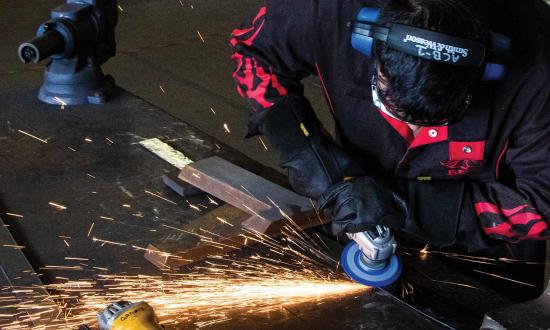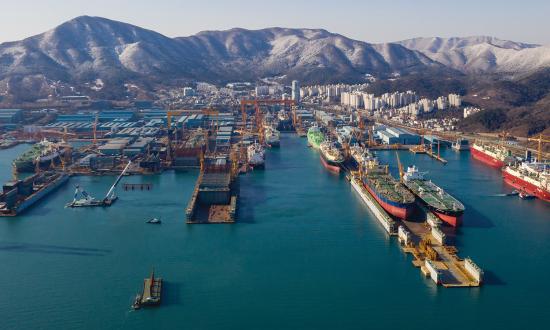Today, China’s shipbuilding industry and the growing capacity of the People’s Liberation Army Navy (PLAN) gives China an overwhelming strategic advantage against the United States in a potential sustained conflict. To withstand the bow wave, the U.S. Navy must field complete and proven capabilities in an efficient, effective, and timely manner—which will require addressing shortcomings in ship design, production, maintenance, and repair, as well as challenges with the supply chain and human capital.
Currently, the United States and China have relative parity in overall economic output. In terms of shipbuilding, however, China has 46.59 percent of the global market and is the largest builder, with South Korea second at 29.24 percent, and Japan third with 17.25 percent. The United States has a relative insignificant capacity at 0.13 percent.
Design
Until the end of the Cold War, the Navy did a good job designing its own ships. However, as more work shifted to private industry, the Navy reduced its in-house naval architecture and engineering staff from roughly 1,200 to 300. Unproven critical ship systems and subsystems were allowed to move to production before they were validated. This led to design and production issues with the littoral combat ship and Zumwalt-class destroyers. There have been similar design missteps with the Gerald R. Ford-class aircraft carriers, San Antonio- and America-class amphibious ships, and Virginia-class submarines.
Critical systems must be proven and tested with other critical systems and subsystems before a ship is produced. To do so, the Navy needs to fully own the technology and data. Further, the systems must be designed so sailors can maintain the equipment while deployed.
Build
The greatest challenge the Navy faces in preparing for a potential war with China is reestablishing its ability to build, maintain, and repair ships. China subsidizes its shipping industry, with 20 large shipyards building military and civilian commercial ships and 140 dry docks to enable rapid expansion and a massive maintenance and damage repair capability.
The United States once considered its merchant fleet and shipyards as strategic capability, and ships and shipyards were subsidized by taxpayers. Unfortunately, subsidizes were eliminated in the 1980s, and the U.S. contribution to global output shrank from 0.50 percent to about 0.05 percent. On a labor and construction cost basis, U.S. shipyards cannot compete with foreign yards. Without a steady supply of contracts, they cannot maintain the industrial infrastructure or employ skilled workers.
Most U.S. naval warships have only one builder, heavily specialized for the specific ship type. To keep cost down, Congress ensures a predictable and stable flow of contracts, which is more affordable for the taxpayer, and provides the builder with stable flow of funds to keep their workforce stable. However, because of this specialization, there is no efficient way to surge or delay production. The shipyards and suppliers do not have alternate customers to take up the slack if the government interrupts a contract. If the government asks a builder to speed up, there is no ready pool of skill workers or equipment in standby. If the U.S. government cannot provide the naval contracts to support the shipyard and its workers, it will need to subsidize the yards to build other commercial ships.
Maintain and Repair
The United States does not have the shipyard capacity to build new ships and fully maintain or repair ships it currently holds in inventory. Given current shipyard capacity, the Navy is estimated to be 20 years behind in maintenance work. Viable ships are being decommissioned because of the inability to maintain, overhaul, modernize, or complete service life extensions. The Government Accountability Office (GAO) is concerned about the backlog, noting in a 2021 report, “In light of ongoing shipyard challenges to keep up with regular maintenance demand, battle damage repairs may further exacerbate these challenges.” The report further noted, “The rise of 21st century adversaries capable of producing high-end threats in warfare—referred to as great power competitors—revives the need for the Navy to reexamine its battle damage repair capability to ensure it is ready for potential conflict.”
Public Yards
Currently, there are four public shipyards in the United States with 17 dry docks. These yards are owned by the U.S. government and support maintenance, depot-level maintenance, emergency repairs, and modernization. In a 2022 report, GAO noted it previously had calculated maintenance delays in aircraft carrier and submarine repairs from fiscal year 2015 through 2019 were equivalent to losing use of more than half a carrier and three submarines each year. “Delays in shipyard maintenance directly affect the Navy’s readiness by hindering its ability to conduct training and operations with its ships,” it added.
To address these issues, the Navy started a 20-year, $21 billion program to replace and modernize infrastructure in 2018. Unfortunately, GAO noted in the 2022 report, “While the condition of the shipyards’ facilities generally improved, they are still among the lowest scored depot facilities across DoD. All shipyards have an average facility condition that is in the ‘Poor’ category.”
To address these critical deficiencies, the public yards should be allocated an additional $30 billion over five years to bring them up to a status of a status of “good”—the best possible score. Further, a separate allocation of $20 billion should be provided to establish a new public yard in San Diego or San Francisco.
Private Yards
The United States should move to increase private ship building capacity from 0.13 percent to 1.3 percent within two years, with an aim to reach 5 percent in five years. This would require economic incentives—i.e., subsidizes—to expand the shipbuilding industry.1 The United States already incentivizes hundreds of industries with subsidizes; having shipyards that can build, maintain, and repair ships in an efficient and effective manner is a national security imperative. Private yards, and the supply chain behind them, should be allocated $50 billion over five years to jumpstart the industry.
Flexibility for Navy and Jobs for Americans
The new subsidizes and direct government investment would drive jobs at the shipyards, providing an opportunity for U.S. industry to rebuild its industrial manufacturing base. Once the industrial base expands, U.S.-based suppliers could decouple critical supply chain items, which are numerous, from China’s supply chain.
It will take time to build, renovate, and reopened shipyards. Specialized equipment will need to be built. It also will take time to recruits and train the workforce. Concurrently, subcontractors and suppliers will need to build their own infrastructure and work forces.
Once the new capacity is in place, the shipyards will be able to throttle up and throttle down naval production or maintenance without putting workers and companies out of business, as they will be subsidized to work on commercial ships when they are not building or repairing naval ships. The increase in shipyards capacity would lower the risk of sole-source contractors producing single ship types and help drive down costs while supporting innovation.
The expanded facilities would have the capacity to tackle the yearslong maintenance backlog, providing the fleet with more advantageous maintenance windows to ensure operational efficiency for maintenance, training, and deployments. Time also would be available for emergency combat repair training at public and private yards, developing the skills needed to quickly return ships to the fight. Capacity could also be allocated to better maintain Ready Reserve Force and National Reserve Fleet ships for emergency use.
Onboard Maintenance and Battle-Damaged Repair
At the end of the Cold War, the Navy also cut or eliminated Shore Intermediate Maintenance Activities (SIMAs); afloat destroyer and submarine tenders that provided intermediate (I-level) maintenance support for deployed ships and submarines; and organizational (O-level) maintenance onboard combat ships. This resulted in a significant loss of fleet maintenance skills, including onboard ship self-sufficiency, material readiness, and battle-damage repair capability. These capabilities must be brought back to the fleet; crews must know how to fix their own ships. The Navy should expand forward SIMAs facilities with its partners worldwide, with emphasis on those adjacent to the South and East China Seas. Afloat destroyer and submarine tenders need to be reestablished. An allocation of $2 billion should be provided to establish these three capabilities.
Allies and Partners
To be successful, the United States needs to integrate with its allies and work closely with numerous partner nations. In the event of war, allies and partners will need to rely South Korea and Japan, the only two counties with enough shipyard capacity to have a meaningful impact.
For now, the United States and other allies could partner with South Korean and Japanese shipbuilders to co-own entities and open additional commercial shipyards as combined national security programs. The United States supported Japanese and South Korean industry during the Cold War to fend off the Soviet Union; the same logic now holds to fend off China.
Options
Until the United States can fully address capacity and shipyard deficiencies, the following stopgap measures could be taken:
- Purchase and store equipment and floating drydocks for later wartime use, ensuring the tools are available to build and repair ships.
- Build proven designs in nonstandard ways—for example, the Arleigh Burke class is built in 70-plus subsections, some of which could be built across the United States. Subsections could be further broken down to allow for shipment via truck, railway, or down the Mississippi or through the Great Lakes to shipyards for final assembly.
- Design and build midsize shallow diving diesel-electric submarines and semisubmersible ships. These could include a mix of manned and unmanned vessels with limited sensors focusing on antiship or antiair missions. The design should allow them to be mass produced in subsections throughout the United States.
- Retrofit civilian ships with limited sensors focusing on antiship and antiair missions.
- Increase the number of aircraft to fill strike and intelligence, surveillance, and reconnaissance (ISR) missions.
- Convert civilian ships into small pocket carries for vertical take-off aircraft and convert smaller ship into lily pads for refueling and rearming.
- Saturate the battle space with small, unmanned ships for ISR and strike capabilities. These platforms could be built in a few small sections throughout the country.
- Increase production of ultra-long-range antisubmarine and antiship missiles. The expanded use of ISR platforms would feed targeting information for extended range weapons.
Looking Forward
The price of peace is high. However, the price of war is far higher. The United States must invest in its public and private shipyards to ensure it has the legs to win a long war. It must get back to the basics and build the industrial and human capacity to compete with China.
1. Congress passed numerous Merchant Marine Acts in 1916, 1920, 1928, 1936, 1946, and 1970 to address to shortfalls with the maritime industry in the belief that they were essential to the nation’s defense. The acts were far less effective than advertised; however, they did provide the United States with significant more capability than it currently possesses.






